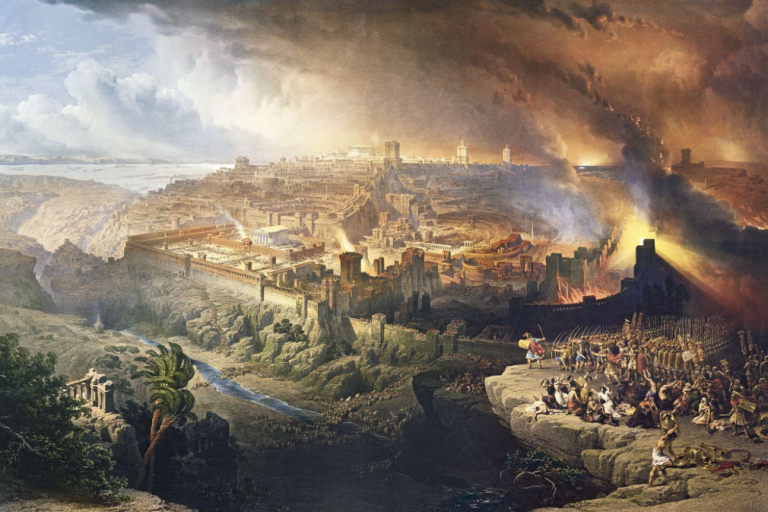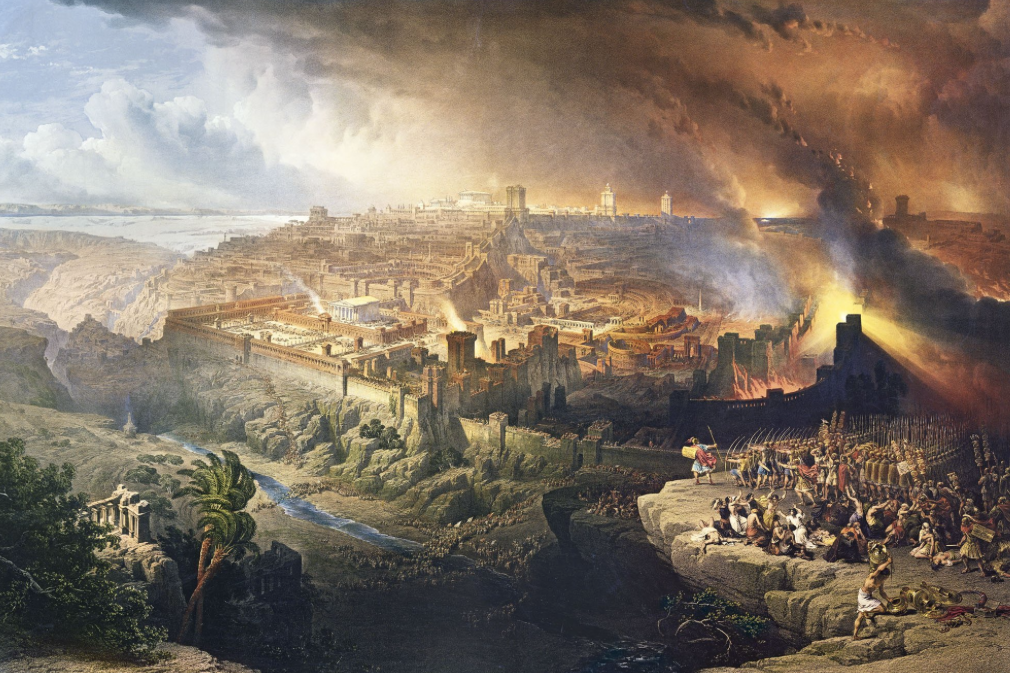And Aharon the Priest went up to Hor Hahar at the command of G-d, and he died there in the fortieth year after the Jewish People had left Egypt, in the fifth month, on the first of the month.” (BaMidbar 33:38)
“Return us to You, O L-rd, and we will return; Renew our days as of old!” (Megillat Eichah 5:21)
 “Chodesh Av,” the Month of Av, is referred to in the Bible as the “Fifth Month,” counting from Nisan, the “First Month.” There is a Biblical reference in BaMidbar (33:38), where we find “And Aharon the Priest went up to Hor Hahar at the command of G-d, and he died there in the fortieth year after the Jewish People had left Egypt, in the fifth month, on the first of the month.” (BaMidbar 33:38). This tragedy, the death of Aharon, was perhaps a signal that this month would be a month of tragedy throughout most of Jewish History. See Biblical Significance for an elaboration of this idea.
“Chodesh Av,” the Month of Av, is referred to in the Bible as the “Fifth Month,” counting from Nisan, the “First Month.” There is a Biblical reference in BaMidbar (33:38), where we find “And Aharon the Priest went up to Hor Hahar at the command of G-d, and he died there in the fortieth year after the Jewish People had left Egypt, in the fifth month, on the first of the month.” (BaMidbar 33:38). This tragedy, the death of Aharon, was perhaps a signal that this month would be a month of tragedy throughout most of Jewish History. See Biblical Significance for an elaboration of this idea.
The name “Av” itself, like all the other names of months in the Hebrew Calendar, “came up” with the Jewish People on their return to the Land of Israel from their Exile in Babylonia. The name of “Menachem Av” is also used. A possible explanation of that name is as follows: “Menachem” in Hebrew means the Comforter; “Av” means “father.” In the name “Menachem Av,” “The One Who comforts, the Av,” could refer to Hashem, Who is called the Father, Who is the only One Who has the ability to comfort the Jewish People for all the tragedies that we have suffered in this month.
Some use the name “Av” through the Ninth of Av; afterwards, when comfort is appropriate, the name “Menachem Av” is used.
Another meaningful interpretation of the name “Menachem Av” is that the word “Av” is spelled “Aleph, Bet.” The Prophet Yirmiyahu, an eye-witness to the destruction of the Temple, Yerushalayim and its population, describes those events in Megillat Eichah, in tears. He builds the structure of the Megillah on the “Aleph-Bet,” meaning not only that it was written in Hebrew, but also that the structure of the chapters themselves is built on the “Aleph-Bet.” This is so in the sense that in the first two of the five chapters as well as the last two, the first verse begins with an “Aleph,” the second with “Bet,” the third with “Gimel,” and so on. And the middle chapter is built on the structure of a triple “Aleph-Bet;” that is, “Aleph, Aleph, Aleph,” “Bet, Bet, Bet,” “Gimel, Gimel, Gimel,” and so on.
It is as if the Holy Language of the Holy People comes to comfort them on the loss of their holy Temple and on the countless other tragedies and massacres suffered by the Jewish People during this month.
And yet another meaningful interpretation of the name, “Menachem Av,” is that it is a valid description of Jewish History that at the darkest times, when there seems to be no hope for the future, a ray of light is found. This is why the Shabbat right after “Shabbat Chazon,” “The Shabbat of the Vision,” on which the Haftarah (the Shabbat Reading from the Prophets) beginning “The vision of Yeshayahu ben Amoz,” which contains the Prophet Yeshayahu’s warning of the impending Destruction, is followed immediately – with Tishah B’Av in the middle – by “Shabbat Nachamu,” the Shabbat in which the Haftarah beginning “Nachamu, Nachamu, Ami,” “Be comforted, Be comforted, My People,” the Haftarah containing Yeshayahu’s description of the ultimate Redemption of Israel.
More often than not, a way is found out of despair by Jewish women, and involves the secret of Jewish marriage, whereby the One Who designed the human soul made it such that each “neshamah,” or soul, has a companion, which it requires for its completion and happiness.
That is why we bless every “Chatan and Kallah,” “bridegroom and bride, that they find the same happiness as did the Original Couple, Adam and Chavah, in “Gan Eden,” the Garden of Eden.
And that is why Miriam’s (sister of Moshe) advice to her father, Amram, in the bleakest time of bondage in Egypt, when the Egyptians were tossing Jewish baby boys into the Nile, to re-marry Yocheved, was so crucial.
And that is also why the last Mishnah in Taanit says that there were no holidays so joyous for the Jewish People as “Tu B’Av,” the Fifteenth of Av (we don’t use the more natural, especially in these metric times, addition of letters “Yud,” 10, and “Heh,” 5, because the combination of those letters is a contracted form of the Name of G-d, and we don’t want to use that Name unnecessarily) and Yom Kippur, …
Biblical Significance of the Month
A Biblical reference to this month in the “Chumash,” the Five Books of Moshe, is the one cited above under Names which speaks of the death of the great “Aharon HaKohen,” Aharon, the Priest. Aharon represented all that is good in the Jewish character, and all that is thrown out when “sinat chinam,” “hatred based on nothing” is brought into Jewish life. Aharon is described in Pirkei Avot as one or better, the one who exemplified the characteristic of “loving peace and pursuing peace, loving people, and bringing them closer to the Torah.”
The Talmud in Masechet Gittin (55b-56a) identifies the immediate cause of the destruction of Yerushalayim as the incident involving Kamtza and Bar-Kamtza. It is clear that although this specific incident may have provoked Rome to move against Yerushalayim, the attitude portrayed in the incident, hardness of heart, reflects that that attitude was deeply ingrained in the hearts of the Jewish People at that time. The story shows the destructive effect of causeless hatred, which, throughout Jewish History, has visited destruction in various forms upon the Jewish People.
Zodiac Sign of the Month
The Zodiac Sign of the Month is the Lion. It is quite possible and likely that this is related to the verse in Eichah, “He is a lurking bear to me, a lion in hiding.” It seems that in the past, to some extent, Hashem has stood aside in this month, and let the “wild animals” of history have their way with us, to teach us where we would be without His protection.
We pray for the time that those “wild animals” will be chased away, or their natures will be changed, as foretold by Yeshayahu, “The wolf will live with the sheep, and the leopard will lie down with the kid; and a calf, a young lion and a young sheep will walk together, and a young child will lead them. A cow and a bear will graze and their young will lie down together; and the lion, like cattle, will eat hay. A nursing child will play by a viper’s hole; and a newly weaned child will stretch his hand towards an adder’s lair. They will neither injure nor destroy in all of my holy mountain; for the earth will be as filled with knowledge of Hashem as water covering the sea bed.” (Yeshayahu 11:6-9)

